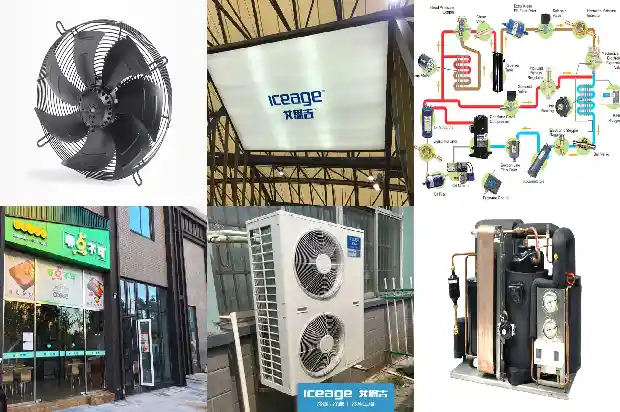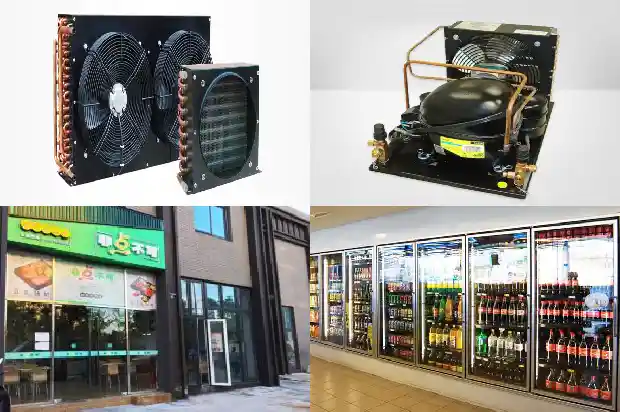Analysis of Refrigeration Compressor Motor Faults
2024-09-19
- Low power supply voltage:
Starting and operating when the power supply voltage is too low. At this time, the current passing through the motor is very large, causing the thermal relay to open and close frequently. Eventually, the contacts melt and stick together, leading to the failure of the thermal relay. Under the action of high current, the winding binding wire of the motor is burned out, and the outer insulation layer of the electromagnetic wire is burned, making part of the winding short-circuited and causing abnormal winding resistance. Low power supply voltage, insufficient power supply capacity, other high-power electrical appliances on the power supply line, too thin selection of power supply line diameter or faults may all cause refrigeration compressor failures. - Motor power supply control circuit failure:
Power switches and contactors are important components of the compressor motor control circuit. Unreasonable selection and lack of maintenance can damage the best refrigeration compressor. Correctly selecting switches and contactors according to the load is extremely important.
It should be especially emphasized that if the contactor contacts are welded together, all controls that rely on the contactor to disconnect the compressor power supply circuit (such as high and low voltage control, oil pressure control, defrosting control, etc.) will be completely ineffective, and the refrigeration compressor is in an unprotected state. Therefore, when the motor is burned out, checking the contactor is an essential step, because the contactor is an important reason that often causes the motor to burn out and is forgotten by people. - Motor failure caused by unbalanced three-phase current:
Abnormal voltage and phase loss can easily destroy the motor. The imbalance of three-phase voltage shall not exceed 5%. Unbalanced three-phase voltage can cause unbalanced three-phase current of the motor.
One phase (or two phases) has excessive current, causing the winding to heat up first and break down or burn out. The currents of other windings will also rise sharply and burn out.When the motor is running, the current value of any one phase and the average value of the three-phase current shall not exceed 10%. As a result of voltage imbalance, the percentage of unbalanced voltage during normal operation can cause 4-10 times the current imbalance of its percentage.
- Abnormal load and locked rotor:
The compressor motor load includes the load required for compressing gas and the load required to overcome mechanical friction. Excessive compression ratio and excessive pressure difference will make the compression process more difficult. The increase in friction caused by lubrication failure and the locked rotor of the motor under extreme conditions will greatly increase the load of the motor.
The torque of the motor of a high-power semi-hermetic compressor is very large. Local wear generally does not cause locked rotor, but the motor output power will increase within a certain range as the load increases, causing more serious wear and even serious damage such as cylinder seizure and connecting rod fracture.
The current during locked rotor (locked rotor current) is about 4-7 times the normal working current. Thermal protection can protect the motor during locked rotor, but generally it will not respond quickly (PTC is slightly faster) to prevent the winding temperature change caused by locked rotor, thus reducing the insulation performance of enameled wire.
- Problems of the motor itself:
National standards have corresponding regulations and requirements for the production of fluorine-resistant motors. However, due to the uneven technical strength, detection instruments, production equipment, especially the level of quality consciousness of various production enterprises, especially the products from small workshops without professional capabilities, it is difficult to avoid the inherent hidden dangers of the motor itself. It is not difficult to avoid this problem, because often such products can find some problems by visual inspection of the appearance and using general detection methods (measuring with a megohmmeter).
For example: the winding end of the motor is loosely and unevenly bound, the insulating paint is unevenly hung and even sticky, the lead-out wire is not selected in accordance with specifications, there is no import mark on the insert (for example, AMP), the enameled wire is arranged in a mess, the insulating material is not selected in accordance with specifications, the insulation resistance to ground and between phases is less than 20MΩ, and the three-phase resistance is unbalanced. - Poor oil return of refrigeration system:
Due to poor oil return of the refrigeration system, the compressor will lack oil and cannot transport enough refrigeration oil to each lubrication part, which will increase the friction of each lubrication part (bushing, piston). In a short time, the piston and crankshaft will be stuck, causing the current of the compressor motor to rise sharply and then burn out the motor coil.
There are various reasons for poor oil return. For example: liquid return, blockage of the throttling valve, blocked oil return hole, inappropriate hole size, or overload operation of the system, and leakage causing lack of oil in the system. - High water content in refrigeration system:
As the coil of the refrigeration compressor motor is soaked in refrigerant and refrigeration oil for a long time, when the water content in the refrigeration system increases, water reacts with refrigeration oil and refrigerant to produce acidic substances. Under the action of certain temperature and pressure, it can corrode the insulation layer of the motor winding coil. In addition, a high water content in the refrigeration system will cause a decrease in the insulation resistance of the winding coil. Under the influence of electromagnetic force, mechanical force and temperature, a chemical reaction will cause the insulation layer of the coil to crack, become brittle and other aging phenomena. As a result, the motor winding coil is short-circuited between phases or turns, and finally causes the motor to burn out.
The sources of moisture in the refrigeration system are: excessive water content in refrigerant and refrigeration oil, which is brought in during charging; when the refrigeration system is opened for maintenance, it is exposed to the air for a long time and absorbs moisture from the air; after maintenance, refrigerant and refrigeration oil are charged without sufficient drying and timely replacement of the desiccant of the filter. - Operation without refrigerant:
Due to long-term operation without refrigerant, the temperature of the compressor cylinder becomes higher and higher, and the expansion deformation becomes larger and larger, resulting in hard friction between the cylinder and the piston. The temperature also becomes higher and higher, causing carbonization of the refrigeration oil, resulting in blackening of the inner cavity and piston. In severe cases, it will cause piston damage, knocking or stuck. This makes the motor generate a large current. Continuous large current will cause the motor winding to burn out. - Vacuum operation:
Due to vacuum operation, the temperature of the compressor cylinder rises rapidly, and the winding coil of the refrigeration compressor motor heats up, causing tiny bubbles to be generated in the coil insulation. At this time, the outside of the winding is in a high vacuum, which easily causes the bubbles to expand and the insulation layer to fall off, causing motor failure. The motor winding coil will be damaged in about two minutes of vacuum operation, making the compressor unable to work normally.
The reasons for vacuum operation of the compressor are generally: powering on without opening the valve, using the compressor to directly evacuate the pipeline system or operating without opening the low-pressure valve. - Foreign matter enters the compressor:
Due to foreign matter entering the compression chamber of the compressor, cracks are generated in the piston and cylinder during reciprocating motion, increasing friction. Foreign matter moves at high speed in the cylinder, damages the suction and exhaust valve plates, and the cylinder temperature rises to elongate the piston groove, knock or get stuck, causing motor failure. The metal chips mixed in the winding are the main culprit for short circuits and low ground insulation resistance.
After metal chips accumulate on the motor winding coil, a short circuit is only a matter of time. As for the source of this foreign matter:
Molding sand and metal chips generated during compressor manufacturing, including copper chips and welding slag left during construction;
Accidentally added when adding refrigerant and refrigeration oil during maintenance;
It may also be broken valve plates or burned copper slag of windings, as well as shaft sleeve wear and motor stator and rotor sweeping.
The failure of the motor of a semi-hermetic refrigeration compressor is related to the links of motor manufacturing, installation, use and maintenance. Its burnout is generally the result of the combined action of multiple factors. If attention is paid to methods during installation, maintenance and maintenance, the possibility of burnout failure will be greatly reduced. To avoid the quickly burned out compressor motor that has been repaired again, the cause of this failure must be resolved, and no new failure factors can be brought in during maintenance. Therefore, correct installation and use of refrigeration compressors and reasonable daily maintenance can prevent the occurrence of unfavorable factors and are the fundamental methods to avoid damage to refrigeration compressor motors.
Related Articles
- Analysis of Seven Reasons for Ice Formation in Computer Room Air Conditioners
- Analysis and Troubleshooting of Common Faults in Air - source Heat Pumps
- Analysis of 6 Components in Air - cooled Multi - split Systems
- Analysis of Advantages, Disadvantages and 34 Common Components of Multi - split Air Conditioners
- Common Causes and Analysis of High and Low Pressure Alarms
- Common Causes and Analysis of Compressor Thermal Protection
- Analysis of Common Faults in Compressor Overcurrent and Burnout
- Analysis of Causes for Safety Valve Leakage
- Fault Analysis of Working Principle of Screw Chiller Unit
- Analysis and Treatment of Common Low-Pressure Faults in Chillers
- Analysis and Treatment of Common Low Pressure Faults in Chillers
- Water Cooled Unit Principle of Operation and Parameter Failure Analysis
- Have You Encountered the Three Common Problems of Refrigeration Compressors?
- How to Calculate Refrigeration Load? And What Are the Issues?
- What to Do if the Compressor of a Frozen and Refrigerated Display Cabinet Runs but the Refrigeration Effect Is Poor?
- Instructions for Welding and Drainage in the Installation of Refrigeration Equipment Pipelines
- Common Pressure Valves and Protection Devices in Refrigeration Units
- Precautions for Using Rotary Refrigeration Compressors
